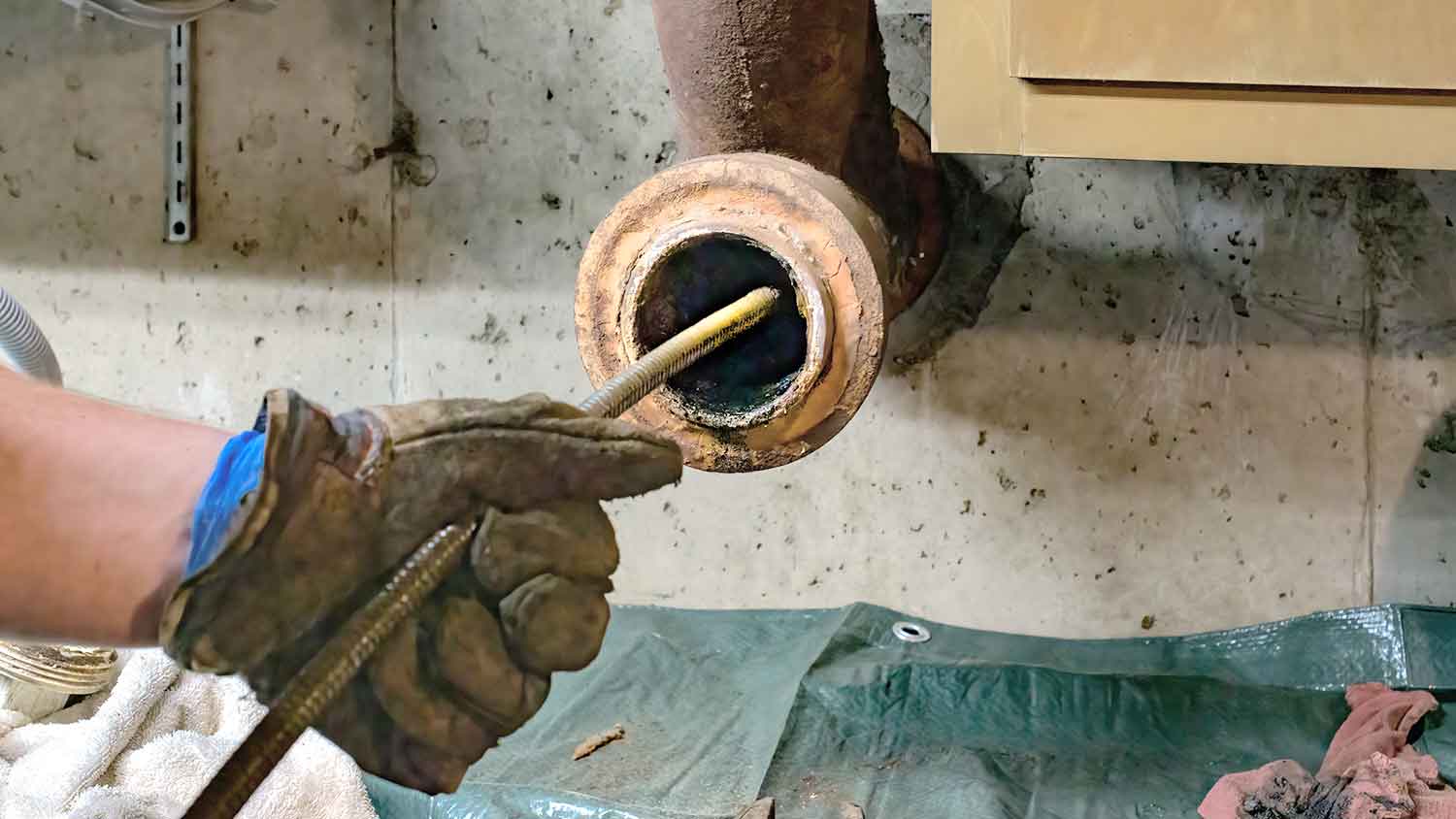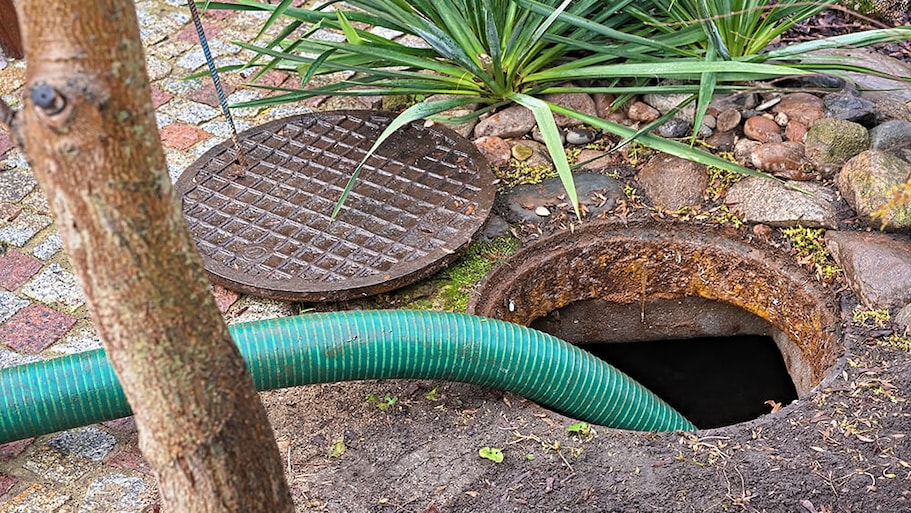Why Your Shower Drain Smells Like Sewage: 6 Common Causes
Find the cause of a stinky shower drain to avoid a big—and costly—mess


Clogs are a common cause of sewer smells in a shower drain.
If the P-trap is dry, it can let sewer gases up through the drain.
Biofilm, often mistaken for mold, can cause a foul odor in and around the shower.
Leaky pipes are an urgent problem that can cause a sewer smell.
Hiring a pro is the safest, fastest way to solve a smelly shower drain.
You step into the shower to wash off the long work day, only to be greeted by a seriously unpleasant smell. When your shower drain smells like sewage, it’s often a sign of something wrong either inside the drain or farther down the pipes. If you’re ready to send that stench back to where it came from, follow this guide for the main causes of a stinky shower drain.
1. The Drain Is Clogged

A lot of hair, soap, and other debris gets rinsed down your shower drain every single day. Some of these products and debris can cling to the pipes and then to each other, leading to a buildup and, ultimately, a clog.
From there, the clog can cause a sewage smell for a couple of different reasons. The organic matter in the clog may smell as it breaks down, or the clog can cause sewer gases from farther in the pipes to leak out through the drain.
Solution
To clear a drain clog on your own, you can use a clean plunger or a snake to break up or pull out the clog. A combination of baking soda and vinegar may also do the trick. As long as you aren’t on a septic system, you can also use a commercial drain cleaner by following the instructions on the label. You shouldn’t use these commercial cleaners with a septic system, though, because the chemicals can kill off the beneficial bacteria in the septic tank that break down solid waste. In that case, only use products that are labeled as safe for septic tanks.
If you can’t clear the clog and need to call in a pro for help, you can expect to spend about $220 for the cost to clean a drain.
2. The P-Trap Is Dry or Dirty
The P-trap in your shower is another common reason why your shower drain smells like sewage. When the P-trap is dry, it can cause sewer gases from the main sewer line to push up through the pipes and into your drain.
So what is the P-trap, and how does it go dry? The section of piping is curved into a U-shape, running from beneath the shower drain to the rest of your home’s plumbing. While you can’t see your shower P-trap, you can see another example of the P-trap beneath the bathroom sink.
Water naturally collects in the curved section of the P-trap, and this creates a liquid seal to prevent smelly sewer gases from coming up through the drains. By using the shower regularly, you keep the water level continuously replenished.
But think about your guest bathrooms or a bathroom located in the basement that is rarely used. For showers that aren’t used often, the water in the P-trap can evaporate or run dry. When this happens, there is no longer a seal to keep sewer gases at bay. Instead, they come up through the drains and stink up your bathroom.
Solution
Running water for a few minutes can help banish the stench. If that doesn’t work, try pouring equal parts baking soda and white vinegar down the drain to clean any debris. If there’s still a sewage smell in the drain, it’s time to call in a pro to check for damage to the pipes.
3. There’s a Buildup of Biofilm
No, biofilm isn’t the latest villain in a new sci-fi movie. This scum is the result of bacteria and bacterial waste, and the bacteria typically arrive to break down the organic waste, like hair, in your drains. The biofilm is pink or orange in color, and many people may mistake it for mold.
Biofilm isn’t just smelly and unsightly. Some biofilms may contain bacteria that can spread diseases, such as Salmonella, E.coli, and Methicillin-resistant Staphylococcus aureus (MRSA). If you’re considering trying to clean out the biofilm yourself, suit up in protective gear, like rubber cleaning gloves, eye goggles, and a face mask.
Solution
Once you’ve put on your protective gear and covered any open wounds to prevent infections, you can use a brush and an antibacterial or enzyme cleaner. First, brush the visible biofilm, then wipe it away. Follow up with the cleaner to disinfect the area, and repeat this process about once a week.
However, it’s not easy to access and clear out biofilm inside the shower drain. You can use a narrow paint roller dipped in the antibacterial cleaner to fit down the drain, twisting it to clean the biofilm. But if you’re concerned about thoroughly cleaning the biofilm down the drain or the whole process just gives you the ick, a drain cleaning pro will be happy to help.
4. Leaky Pipes
Your pipes are designed to move wastewater from around the house to the main sewer line, where the wastewater and solid waste will be carried away, either to a municipal wastewater management system or the septic tank on your property for treatment.
But if the pipes break, wear down, or the fittings between pipes become loose, the raw sewage and wastewater can leak out. Not only does this allow sewer gases to move up through the pipes and into your home, but it also means contaminated water and solid waste can leak out either into the ground, behind the walls, and under the floors.
Pipes can leak for a number of reasons. General wear and tear or improper installation may cause fittings to come loose. If you live in an earthquake-prone area, vibrations from the quake may cause pipes to break. Metal pipes are vulnerable to corrosion. If you have deep-rooting plants in your yard that are growing near the main sewer line or near any pipes that lead to and from the septic tank, the roots can also grow into the pipes.
Solution
Leaking pipes warrant an emergency call to the plumber. Don’t try to fix the pipes on your own, especially if they are leaking wastewater. Exposure to sewage and even sewer gases can cause illnesses like gastroenteritis, typhoid fever, and giardiasis, and can be fatal when untreated.
5. The Sewer Main Line Is Clogged

While the package on a container of wet wipes might read flushable, wet wipes are a common problem for sewer main lines. Other common items that clog the line include feminine hygiene products, paper towels, and cigarettes. No need to be embarrassed if you’ve been flushing some of these items, but be sure to only flush human waste and toilet paper moving forward.
Clogs can also happen when things like cooking oils, grease, or coffee grounds are poured down the kitchen sink. After you pour these substances down the drain, they can solidify and gunk up the pipes.
But how can these items that end up down the toilet or kitchen sink cause a smelly shower drain? You may wonder in horror, “Is my kitchen sink connected to my bathroom sewage pipe?”
The fixtures and appliances around your home have separate drains and pipes, but these pipes all come together to the sewer main line. This line can become clogged from various points in the house, and that can cause the sewer smells and even wastewater to back up into your shower drain.
Solution
You can try to clear a main sewer line clog yourself with home remedies like boiling water or baking soda and vinegar, but your best bet is to hire a sewer cleaner to inspect the line and clear the clog.
6. The Septic Tank Needs Pumped
If you live in a home with a septic system, you shouldn’t smell any sewer gases from the septic tank. But if those sewage smells do come inside the house, through the shower drains or elsewhere, it may be a sign that the septic tank is full and due for a pumping.
With a septic system, wastewater travels from the house to the septic tank, where solid waste sinks to the bottom of the tank. The filtered wastewater then moves further through the system to the leach field, where it will be treated and slowly dispersed into the soil.
The solid waste will naturally collect at the bottom of the tank, and it needs pumped from time to time. The solid waste shouldn’t be left to build up to more than a third of the tank (or six inches within the bottom of the outlet pipe that moves wastewater to the leach field). Otherwise, it can cause wastewater to back up into shower or basement drains in the house.
Solution
The only way to clean a full septic tank is to hire a pro to pump the tank. This job requires special equipment, and exposure to sewer gas can be dangerous, as it contains gases like hydrogen sulfide that are toxic to humans.
You should only need to have the septic tank pumped every three to five years to prevent sewer smells or raw sewage from backing up into your home’s drains. Be sure to budget about $175 to $600 for the septic tank pumping cost.
What to Do When Your Shower Drain Smells Like Sewage
Though it’s perfectly safe to still shower if it just smells like sewage (as long as you don’t see swage actively bubbling up out of the drain), it’s not the most pleasant environment to be in while you’re trying to get clean. You may try plunging or snaking the shower drain to no avail, or you might suspect a clog further down the sewer main line. If you can’t find the cause of your shower drain smell or you need help fixing the problem, hire a local sewer line repair company to help.
The pros can use special equipment, like plumbing cameras, to access parts of the plumbing that you just can’t get to on your own. From there, the sewer line repair specialist will be able to diagnose the problem and suggest the best solution so that you can get back to enjoying your showers without uninvited smells creeping in.





- How to Clear a Main Sewer Line Clog Yourself in 7 Ways
- 7 Common Causes of a Septic Smell in Houses and How to Fix It
- Why Does My Bathroom Sink Drain Smell? 5 Causes and How to Solve Them
- How a Shower Drain Works: Plumbing Diagram
- 10 Most Common Plumbing Problems Every Homeowner Should Know
- Septic vs. Sewer: Which Wastewater Management System Is Best for Your Property?
- Here’s What to Put in a Septic Tank to Break Down Solids
- How to Unclog a Shower Drain With Standing Water
- 8 Warning Signs of a Clogged Sewer Line
- How to Keep Your Sewer Sanitary Line Clean and Clear










